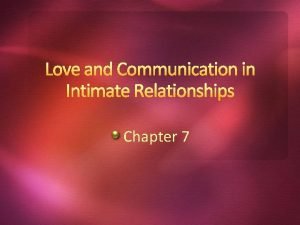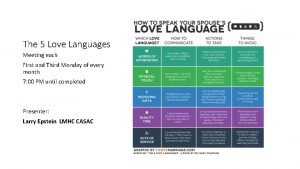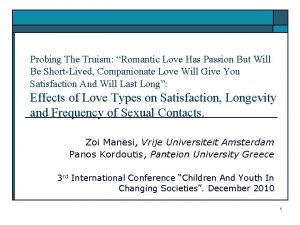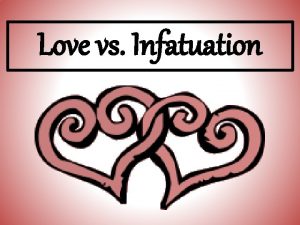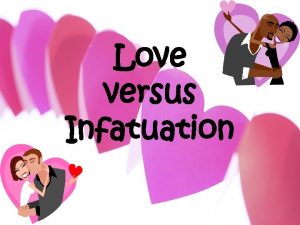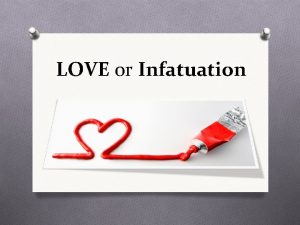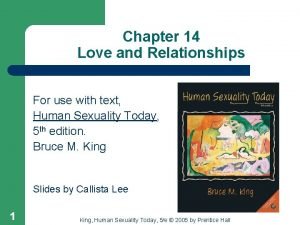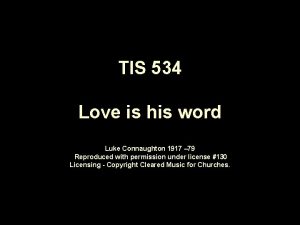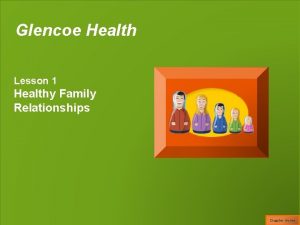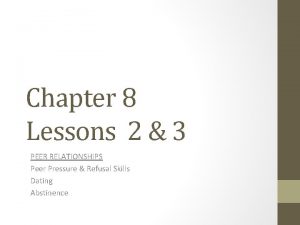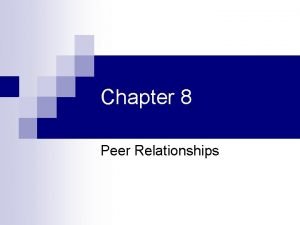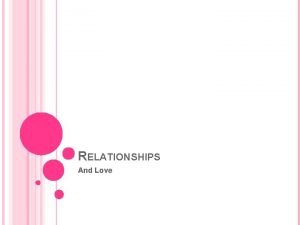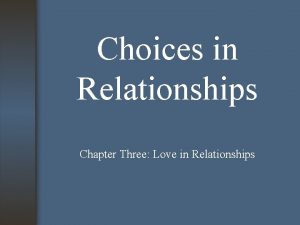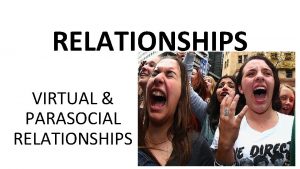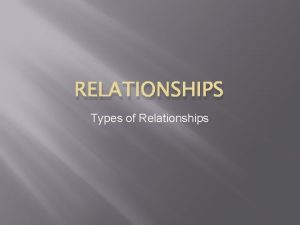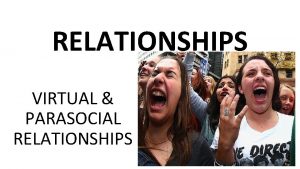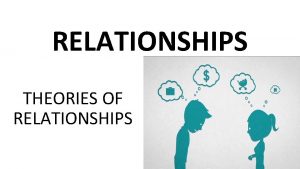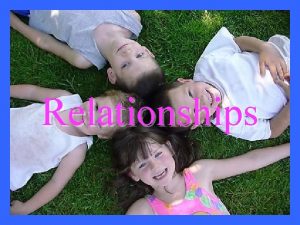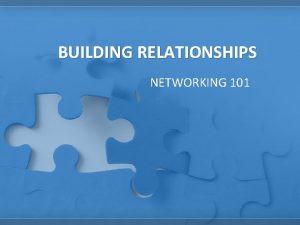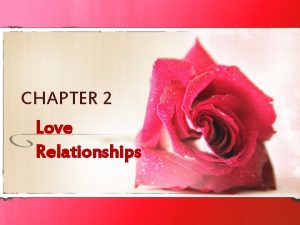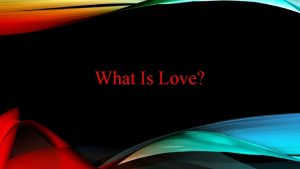CHAPTER 2 Love in Relationships What is love





























- Slides: 29

CHAPTER 2 Love in Relationships

What is love?

Discussion What are some ways we show love?

Ways of Conceptualizing Love • Love: is about deep abiding feelings • Lust: is about sexual desire & present • Infatuation: is about emotional feeling based on little actual exposure to love object

Romantic Love • Love at first sight, one true love • Excitement, passion • Individuals who fell in love fast had similar marital happiness as couples who fell in love gradually. • Men fall in love more quickly b/c they are visually attracted to young females for reproduction

Realistic Love/ Conjugal Love • • • love between married people companionship calmness comfort security

Romantic vs. Realistic love This photo illustrates • Romantic love (young couple) • Conjugal love(older couple) • Both types of love are good • People in either category can be happy in their relationships

John Lee 1973, 1988 Love Styles Describe the way in which lovers relate to each other

Love Styles Ludic Juggle partners Love d an m e ‘ m e e v ‘ o e L v a e l Manipulative & uncaring

Love Styles l a ic g o L PRAGMA l a n it o a R

Love Styles Most common for College Students EROS LOVE Sexual love

Love Styles Out of control MANIA LOVE e v i s s e s s o P Gehring A T S R E LK

Love Styles g n i th o o S STORGE Lov LOVE e be twe en p erso ns l ong Non sexual mar ried

Love Styles Selfless Love AGAPE LOVE G g n i v i e v lo Love between parent and child

Triangular View of Love by Sternberg 1986 7. Consummate Love Intimacy, passion, commitment on 3. Conjugal Love Intimacy & Commitment Int ima 2. Romantic love Intimacy & Passion ssi 6. Empty Love commitment Pa 1. Nonlove None of the above cy 3 basic elements to love: Intimacy, Passion & Commitment. 4. Liking Intimacy only 5. Fatuous Love Passion & commitment Commitment

Not in book The Need for Intimacy is experiencing the essence of one’s self in intense intellectual, physical, and/or emotional communion with another human being.

How would you feel if your family was in charge of finding you a husband/wife?

*Arranged Marriage • • 40 % of the worlds population arrange marriage Parents arrange 80% of marriages in China, India & Indonesia Focus is on linking the two families together How the couples feel about each other is irrelevant Love will come after marriage Parents will interview suitable partner Parents may put an advertisement in newspaper • Why do some cultures practice arranged marriages? • Do you think that your parents have influence over who date/marry?

Theories on the Origins of Love Evolutionary Theory Love has an evolutionary purpose and creates a bond between parents when their offspring are dependent infants.

Theories on the Origins of Love Learning Theory Emphasizes that love feelings develop in response to certain behaviors occurring in certain contexts. Ex: doing thing for your partner Holding hands, kissing, texting, buying gifts, All of these examples can encourage the development of love. What are some words of endearment used?

Theories on the Origins of Love Sociological Theory : love develops in stages, like a wheel 1. rapport: knowing someone, feeling comfortable w/someone 2. self revelation: each partner reveals intimate thought about yourself, partner, the relationship. 3. mutual dependency: partners are happy being together & their happiness depends on the other. “I’m the happiest when I’m with you! 4. personality need fulfillment: the desire to love and be loved, to trust and be trusted, to support and be supported.

Theories on the Origins of Love Psychosexual Theory(Freud) Love results from blocked biological sexual desires. In reverse – once you had sex love dies

Theories on the Origins of Love Biochemical Theory Suggests that there may be a biochemical basis for love feelings. Oxytocin is a hormone that encourages contractions during childbirth and endears the mother to the suckling infant Referred to as the ‘cuddle chemical’

Theories on the Origins of Love Attachment Theory Emphasizes a primary motivation in life is to be connected with other people.

Falling in LOVE • Society promotes love through popular music, movies, television, and novels. • Probability of being in a relationship is influenced by the cultural ideal of physical appearance. • What are some of today’s standards of beauty for women and men?

Falling in LOVE The individual must be physiologically aroused. Self-esteem and self-disclosure associated with the development of healthy love relationships.

Benefits of Self. Esteem 1. It allows one to be open and honest about both strengths and weaknesses. 2. It allows one to feel generally equal to others. 3. It allows one to take responsibility for one’s own feelings, ideas, mistakes, and failings. 4. It allows for the acceptance of strengths and weaknesses in one’s self and others.

Benefits of Self. Esteem 5. It allows one to validate one’s self and not to expect the partner to do this. 6. It permits one to feel empathy 7. It allows separateness and interdependence, as opposed to fusion and dependence.

8 dimensions of Self-Disclosure 1. 2. 3. 4. 5. 6. 7. 8. backgrounds and history feelings toward the partner feelings toward self feelings about one’s body attitudes toward social issues tastes and interests money and work feelings about friends
 Love love jesus is love god greatest gift lyrics
Love love jesus is love god greatest gift lyrics Love and communication in intimate relationships
Love and communication in intimate relationships Friendly relationship chapter 7
Friendly relationship chapter 7 Love language examples
Love language examples The salvation of man is through love and in love
The salvation of man is through love and in love That you must love me and love my dog summary
That you must love me and love my dog summary Passionate love vs companionate love
Passionate love vs companionate love Passionate love vs companionate love
Passionate love vs companionate love Infatuation meanin
Infatuation meanin Infatuation in a sentence
Infatuation in a sentence Infatuation vs love
Infatuation vs love Love is patient love is blind
Love is patient love is blind Consummate love vs companionate love
Consummate love vs companionate love Types of love
Types of love Love language test
Love language test Love for the sake of love
Love for the sake of love Your love never fails
Your love never fails Oh my love my darling ive hungered for your touch
Oh my love my darling ive hungered for your touch Courtly love tradition
Courtly love tradition Richer than gold is the love of my lord lyrics
Richer than gold is the love of my lord lyrics Love is love tautology
Love is love tautology Love begets love
Love begets love Chapter 7 lesson 1 healthy family relationships
Chapter 7 lesson 1 healthy family relationships Chapter 8 peer relationships answer key
Chapter 8 peer relationships answer key Chapter 7 lesson 1 healthy family relationships answer key
Chapter 7 lesson 1 healthy family relationships answer key Chapter 2 principles of ecology
Chapter 2 principles of ecology Principles of ecology chapter 2 section 1 answer key
Principles of ecology chapter 2 section 1 answer key Section 1 organisms and their relationships
Section 1 organisms and their relationships Chapter 2 principles of ecology answers
Chapter 2 principles of ecology answers Chapter 8 healthy peer relationships
Chapter 8 healthy peer relationships

